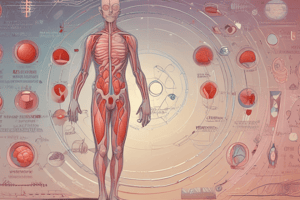Podcast
Questions and Answers
What is the main function of homeostasis in the human body?
What is the main function of homeostasis in the human body?
- To regulate emotional responses
- To promote muscle growth
- To maintain a stable internal environment (correct)
- To stimulate hunger
Which hormone promotes glucose uptake by cells and conversion to glycogen in the liver?
Which hormone promotes glucose uptake by cells and conversion to glycogen in the liver?
- Glucagon
- Thyroxine
- Adrenaline
- Insulin (correct)
What is the role of the hypothalamus in thermoregulation?
What is the role of the hypothalamus in thermoregulation?
- To regulate vasoconstriction
- To promote shivering
- To act as the body's thermostat (correct)
- To stimulate sweating
What is the purpose of vasoconstriction in response to cold temperatures?
What is the purpose of vasoconstriction in response to cold temperatures?
What type of neurons carry impulses from receptors to the CNS?
What type of neurons carry impulses from receptors to the CNS?
What is the term for the maintenance of a stable internal body temperature?
What is the term for the maintenance of a stable internal body temperature?
What is the role of glucagon in regulating blood glucose levels?
What is the role of glucagon in regulating blood glucose levels?
What is the purpose of negative feedback in homeostasis?
What is the purpose of negative feedback in homeostasis?
What is the role of a relay neurone in the CNS?
What is the role of a relay neurone in the CNS?
What is the primary function of synapses?
What is the primary function of synapses?
What is the primary function of FSH in the menstrual cycle?
What is the primary function of FSH in the menstrual cycle?
What is the primary function of progesterone in the menstrual cycle?
What is the primary function of progesterone in the menstrual cycle?
What is the primary function of auxins in plant growth?
What is the primary function of auxins in plant growth?
What is the term for the growth of a plant towards light?
What is the term for the growth of a plant towards light?
What would be a suitable control group in an experiment investigating the effect of light on plant growth?
What would be a suitable control group in an experiment investigating the effect of light on plant growth?
What is the expected outcome of an experiment investigating the effect of light on plant growth?
What is the expected outcome of an experiment investigating the effect of light on plant growth?
Flashcards are hidden until you start studying
Study Notes
Homeostasis
- Homeostasis is the regulation of internal conditions to maintain a stable internal environment, crucial for optimal functioning of cells and enzymes
- The pancreas monitors blood glucose levels and releases hormones to regulate it
- High blood glucose levels: detected by the pancreas, insulin is released, promoting glucose uptake by cells and conversion to glycogen in the liver
- Low blood glucose levels: detected by the pancreas, glucagon is released, promoting the breakdown of glycogen to glucose in the liver
- Negative feedback ensures that blood glucose levels are kept within a narrow range
Thermoregulation
- Thermoregulation is the maintenance of a stable internal body temperature
- The hypothalamus acts as the body's thermostat
- Response to heat:
- Sweating: sweat glands release sweat, which evaporates and cools the body
- Vasodilation: blood vessels widen, increasing blood flow to the skin, allowing more heat to be lost
- Response to cold:
- Shivering: muscles contract rapidly, generating heat
- Vasoconstriction: blood vessels narrow, reducing blood flow to the skin, conserving heat
- Behavioural responses:
- Seeking shade or drinking water in hot conditions
- Wearing more clothing or seeking warmth in cold conditions
Nervous System
- The nervous system detects and responds to stimuli
- Types of neurones:
- Sensory Neurones: carry impulses from receptors to the CNS
- Relay Neurones: connect sensory and motor neurones within the CNS
- Motor Neurones: carry impulses from the CNS to effectors
- Pathway of a reflex arc:
- Stimulus → Receptor → Sensory Neurone → Relay Neurone → Motor Neurone → Effector → Response
- Function of synapses:
- Synapses are gaps between neurones
- Neurotransmitters are released from one neurone and cross the synapse to the next neurone
Hormonal Control of Menstrual Cycle
- The menstrual cycle is controlled by hormones to prepare the body for pregnancy
- Role of FSH (Follicle-Stimulating Hormone):
- Produced by the pituitary gland
- Stimulates the maturation of eggs in the ovaries and production of oestrogen
- Role of LH (Luteinizing Hormone):
- Produced by the pituitary gland
- Triggers ovulation and stimulates the production of progesterone
- Role of Oestrogen:
- Produced by the ovaries
- Causes the lining of the uterus to thicken
- Inhibits FSH and stimulates LH production
- Role of Progesterone:
- Produced by the corpus luteum
- Maintains the lining of the uterus
- Inhibits LH and FSH production to prevent the maturation of more eggs
Plant Hormones and Growth
- Auxins are plant hormones that regulate growth by promoting cell elongation
- Auxins are distributed unevenly in response to light, causing differential growth rates
- Phototropism: growth of a plant towards light
- Auxins accumulate on the shaded side of the plant, causing cells to elongate more on that side, bending the plant towards the light
Experimental Setup for Investigating the Effect of Light on Plant Growth
- Use seedlings in identical pots with one group exposed to light from one side and the other group not exposed to light.
Studying That Suits You
Use AI to generate personalized quizzes and flashcards to suit your learning preferences.




